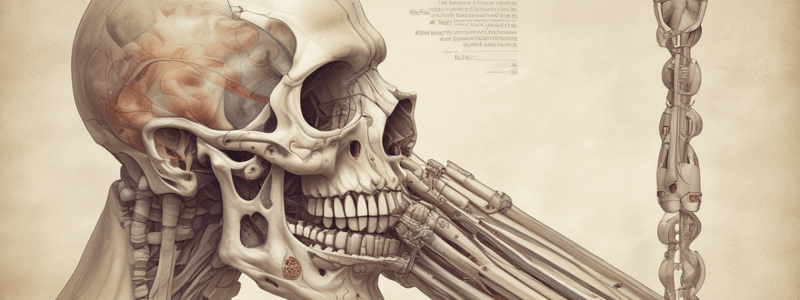Podcast
Questions and Answers
What type of connective tissue connects articulating bones in fibrous joints?
What type of connective tissue connects articulating bones in fibrous joints?
Dense regular connective tissue
What is the primary function of fibrous joints?
What is the primary function of fibrous joints?
To hold together two bones
What are the three types of fibrous joints?
What are the three types of fibrous joints?
Gomphoses, sutures, and syndesmoses
What is a gomphosis, and where is it located in the human body?
What is a gomphosis, and where is it located in the human body?
What holds a tooth firmly in place in a gomphosis?
What holds a tooth firmly in place in a gomphosis?
Why are orthodontic braces painful and take so long to correctly position the teeth?
Why are orthodontic braces painful and take so long to correctly position the teeth?
What type of joint is a syndesmosis functionally classified as?
What type of joint is a syndesmosis functionally classified as?
What is the main difference between a gomphosis and a suture?
What is the main difference between a gomphosis and a suture?
Describe the relationship between osteoblasts and osteoclasts in the alveolar process.
Describe the relationship between osteoblasts and osteoclasts in the alveolar process.
What is a gomphosis, and where is it primarily found in the body?
What is a gomphosis, and where is it primarily found in the body?
Explain the functional classification of sutures and their role in skull development.
Explain the functional classification of sutures and their role in skull development.
What changes do sutures undergo in older adults?
What changes do sutures undergo in older adults?
What structural features define syndesmoses and their locations?
What structural features define syndesmoses and their locations?
What type of movement is permitted by syndesmoses?
What type of movement is permitted by syndesmoses?
Describe the interosseous membrane's role in syndesmoses.
Describe the interosseous membrane's role in syndesmoses.
How does the composition of sutures contribute to their functionality?
How does the composition of sutures contribute to their functionality?
Flashcards are hidden until you start studying
Study Notes
Fibrous Joints
- Articulating bones in fibrous joints are connected by dense regular connective tissue.
- Fibrous joints have no joint cavity, thus, they lack a space between the articulating bones.
- Most fibrous joints are immobile or at most only slightly mobile; their primary function is to hold together two bones.
- Examples of fibrous joints include the articulations of the teeth in their sockets, sutures between skull bones, and articulations between either the radius and ulna or the tibia and fibula.
Gomphoses
- A gomphosis is a synarthrosis (immobile joint) between a tooth and the jaw.
- Gomphoses resemble a "peg in a socket".
- The only gomphoses in the human body are the articulations of the roots of individual teeth with the alveolar processes (sockets) of the mandible and the maxillae.
- A tooth is held firmly in place by fibrous periodontal (per′ē-ō-don′tăl; peri = around, odous = tooth) membranes.
- This joint is immobile and thus is functionally classified as a synarthrosis.
Sutures
- Sutures are fibrous joints found only between certain bones of the skull.
- Sutures are functionally classified as synarthroses, since they are immobile joints.
- Sutures have distinct, interlocking, usually irregular edges that both increase their stability and decrease the number of fractures at these articulations.
- Sutures permit the skull to grow (by new bone being deposited at these sutures) as the brain increases in size during childhood.
- In an older adult, the dense regular connective tissue in the suture becomes ossified, fusing the skull bones together.
Syndesmoses
- Syndesmoses are fibrous joints in which articulating bones are joined by long strands of dense regular connective tissue only.
- Because syndesmoses allow for slight mobility, they are classified functionally as amphiarthroses.
- Syndesmoses are found both between the radius and ulna and between the tibia and fibula.
- The shafts of the two articulating bones are bound by a broad, ligamentous sheet called an interosseous membrane (or interosseous ligament).
- The interosseous membrane provides a pivot where the radius and ulna (or the tibia and fibula) can move relative to one another.
Studying That Suits You
Use AI to generate personalized quizzes and flashcards to suit your learning preferences.



